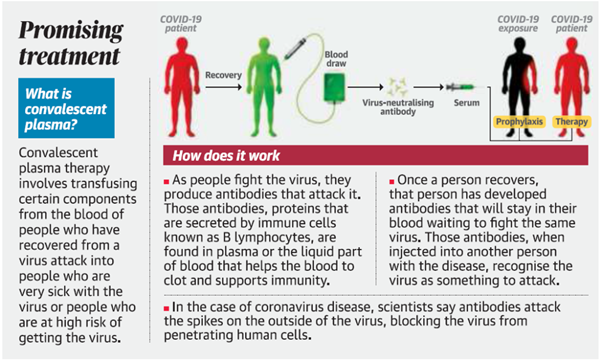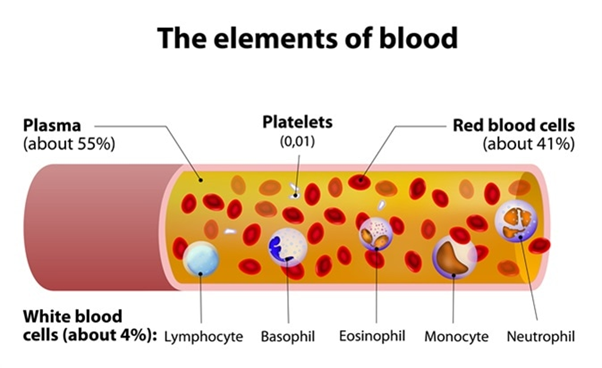Focus: GS-III Science and Technology
Why in news?
The Karnataka State Government laid down the guidelines specified for convalescent plasma therapy.
Guidelines
- A recovered COVID-19 patient should have preferably had symptoms such as fever, cough and cold as there is a greater possibility of the presence of anti-SARS-CoV-2 IgG antibodies compared to an asymptomatic patient.
- That said, plasma from asymptomatic donors can be accepted if the antibodies are present.
- People who have recovered from COVID-19 and wish to donate their plasma should be in the 18 to 60 age group.
- Besides this, donors should either be male or women who have not given birth. All donors must weigh over 50 kg. This is to mitigate the risk of transfusion related to acute lung injury.
What is Convalescent plasma therapy?
- The convalescent plasma therapy aims at using antibodies from the blood of a recovered Covid-19 patient to treat those critically affected by the virus. The therapy can also be used to immunise those at a high risk of contracting the virus — such as health workers, families of patients and other high-risk contacts.
- This therapy’s concept is simple and is based on the premise that the blood of a patient who has recovered from Covid-19 contains antibodies with the specific ability of fighting novel coronavirus. The theory is that the recovered patient’s antibodies, once ingested into somebody under treatment, will begin targeting and fighting the novel coronavirus in the second patient.
- The convalescent plasma therapy is akin to passive immunisation as, according to researchers, it is a preventive measure and not a treatment for the Covid-19 disease.

Has plasma therapy been used earlier?
- The method ‘Convalescent Serum Therapy’ dates to 1918; when it was used during the outbreak of the Spanish Flu.
- After which it has been used in 2005 during the SARS epidemic.
- According to the medical journal The Lancet, it was used to improve the survival rates of patients.
- In 2009 it was used for H1N1 patients, 2014 for those infected by Ebola in 2014 and in 2015 for MERS patients in different parts of the world.
- Others serious outbreaks that have seen the use of this therapy are the SARS outbreak, Measles, HIV, polio and mumps.
Whose plasma is collected for Plasma Therapy?
- The blood is taken from the recovered patient and the plasma is separated. It is then tested for the antibodies and then administered to Covis-19 patients who is critically ill.
How Convalescent Plasma Therapy works?
- The convalescent plasma therapy uses antibodies developed within an infected person while he/she is infected with the novel coronavirus.
- These antibodies are developed in a patient as part of the body’s natural immune response to a foreign pathogen or in this case, the novel coronavirus. These antibodies are highly specific to the invading pathogen. Hence, they work to eliminate the novel coronavirus from the patient’s body.
- Once the patient has recovered, they donate their blood so that their antibodies can be used to treat other patients. The donated blood is then checked for the presence of any other disease-causing agents such as Hepatitis B, Hepatitis C, HIV etc.
- If deemed safe, the blood is then taken through a process to extract ‘plasma’, the liquid part of the blood that contains antibodies. The antibody-rich plasma, once extracted, is then ingested into the body of a patient under treatment.
Risks involved in Plasma Therapy
Besides speaking about the success of the convalescent plasma therapy, the study by John Hopkins immunologists stated some of the risks associated with it:
- Transfer of blood substances: As the blood transfusion takes place, there are risks that an inadvertent infection might get transferred to the patient.
- Enhancement of infection: The therapy might fail for some patients and can result in an enhanced form of the infection.
- Effect on immune system: The antibody administration may end up suppressing the body’s natural immune response. This will leave a Covid-19 patient vulnerable to subsequent re-infection.
What is Plasma?
Plasma is the clear, straw-coloured liquid portion of blood that remains after red blood cells, white blood cells, platelets and other cellular components are removed. It is the single largest component of human blood. Plasma comprises about 55 percent, and contains water, salts, enzymes, antibodies and other proteins.

- Composed of 90% water, plasma is a transporting medium for cells and a variety of substances vital to the human body.
- Plasma carries out a variety of functions in the body, including clotting blood, fighting diseases and other critical functions.
- Source plasma is plasma that is collected from healthy, voluntary donors through a process called plasmapheresis and is used exclusively for further manufacturing into final therapies (fractionation). Source plasma donors may be compensated for their time and effort.
- Recovered plasma is collected through whole blood donation in which plasma is separated from its cellular components. Recovered plasma may be used for fractionation.
-Source: The Hindu





